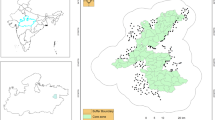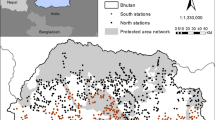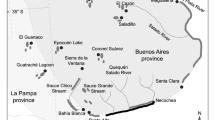Abstract
Context
Changing global environmental conditions, especially at northern latitudes, are threatening to shift species distributions and alter wildlife communities.
Objective
We aimed to establish current distributions and community arrangements of small mammals to provide important baselines for monitoring and conserving biodiversity into the future.
Methods
We used 4,408 archived museum and open-access records and the machine learning algorithm, RandomForests, to create high-resolution spatial niche models for 17 species of rodents and shrews in Alaska. Models were validated using independent trapping results from 20 locations stratified along statewide mega-transects, and an average species richness curve was calculated for field samples. Community cluster analyses (varclus) identified geographic patterns of sympatry among species. Species models were summed to create the first small-mammal species richness map for Alaska.
Results
Species richness increased logarithmically to a mean of 3.3 species per location over 1,500 trap-nights. Distribution models yielded mean accuracies of 71 % (45–90 %), and maps correctly predicted a mean of 75 % (60–95 %) of occurrences correctly in the field. Top predictors included Soil Type, Ecoregion, Landfire Land-cover, December Sea Ice, and July Temperature at the geographic scale. Cluster analysis delineated five community groups (3–4 species/group), and species richness was highest (11–13 species) over the Yukon-Tanana Uplands.
Conclusions
Models presented here provide spatial predictions of current small mammal biodiversity in Alaska and an initial framework for mapping and monitoring wildlife distributions across broad landscapes into the future.





Similar content being viewed by others
References
Aarssen LW (1997) High productivity in grassland ecosystems: affected by species diversity or productive species? Oikos 80:183–184
Arctic Climate Impact Assessment (2005) Impacts of a warming Arctic. Arctic Climate Impact Assessment (ACIA), Cambridge
Assogbadjo A, Sinsin B, Codjia J, Damme PV (2005) Ecological diversity and pulp, seed, and kernel production of the Baobab (Adansonia digitata) in Benin. Belg J Bot 138:47–56
Baltensperger AP, Mullet TC, Schmid MS, Humphries G, Kövér L, Huettmann F (2013) Seasonal observations and machine-learning-based spatial model predictions for the common raven (Corvus corax) in the urban, sub-arctic environment of Fairbanks, Alaska. J Polar Biol 36:1587–1599
Booms TL, Huettmann F, Schempf PF (2010) Gyrfalcon nest distribution in Alaska based on a predictive GIS model. Polar Biol 33:347–358
Breiman L (1996) Bagging predictors. Mach Learn 24:123–140
Breiman L (2001a) Random forests. Mach Learn 45:5–32
Breiman L (2001b) Statistical modeling: the two cultures. Stat Sci 16:199–231
Buckner CH (1964) Feeding behavior in four species of shrews. Can J Zool 42:259–279
Burnham K, Anderson D (2002) Model selection and multimodel inference: a practical information-theoretic approach. Springer, New York, p 488
Bush MB (2002) Distributional change and conservation on the Andean flank: a palaeoecological perspective. Clim Change Conserv Spec Issue 11:463–473
Carleton MD, Gardner AL, Pavlinov IY, Musser GG (2014) The valid generic name for red-backed voles (Muroidea: Cricetidae: Arvicolinae): restatement of the case for Myodes Pallas, 1811. J Mammal 95:943–959
Churchfield S, Nesterenko VA, Shvarts EA (1999) Food niche overlap and ecological separation amongst six species of coexisting forest shrews (Insectivore: Soricidae) in the Russian Far East. J Zool 248:349–359
Cohen J (1960) A coefficient of agreement for nominal scales. Educ Psychol Measur 20:37–46
Cushman SA (2010) Space and time in ecology: noise or fundamental driver? In: Cushman SA, Huettmann F (eds) Spatial complexity, informatics, and wildlife conservation. Springer, New York, p 24
Cutler DR, Edwards KH Jr, Cutler A, Hess KT, Gibson J, Lawler JJ (2007) Random forests for classification in ecology. Ecology 88:2783–2792
De’ath G, Fabricius KE (2000) Classification and regression trees: a powerful yet simple technique for ecological data analysis. Ecology 81:3178–3192
Drew CA, Wiersma YF, Huettmann F (2011) Predictive species and habitat modeling in landscape ecology. Springer, Berlin, p 314
Duffy JE, Cardinale BJ, France KE, McIntyre PB, Thébault E, Loreau M (2007) The functional role of biodiversity in ecosystems: incorporating trophic complexity. Ecol Lett 10:522–538
Elith J, Leathwick J (2007) Predicting species distributions from museum and herbarium records using multi-response models fitted with multivariate adaptive regression splines. Divers Distrib 13:265–275
Elith J, Graham CH, Anderson RP et al (2006) Novel methods improve prediction of species’ distributions from occurrence data. Ecography 29:129–151
Elith J, Leathwick JR, Hastie T (2008) A working guide to boosted regression trees. J Anim Ecol 77:802–813
Evans JS, Murphy MA, Holden ZA, Cushman SA (2011) Modeling species distribution and change using Random Forest. In: Drew CA, Wiersma YF, Huettmann F (eds) Predictive species and habitat modeling in landscape ecology. Springer, Berlin, p 22
Fielding AH, Bell JF (1997) A review of methods for the assessment of prediction errors in conservation presence/absence models. Environ Conserv 234:38–49
Fritts E, Burch M, Rabe M, Schwarber J, McCracken B (2006) Our wealth maintained: a strategy for conserving Alaska’s diverse wildlife and fish resources. Alaska Department of Fish and Game, Juneau, AK, p 852
Gilg O, Sittler B, Hanski I (2009) Climate change and cyclic predator–prey population dynamics in the high Arctic. Glob Change Biol 15:2634–2652
Gotthardt T, Pyare S, Huettmann F et al (2013) Predicting the range and distribution of terrestrial vertebrate species in Alaska. The Alaska Gap Analysis Project, University of Alaska, Anchorage, p 40
Gough L, Ramsey EA, Johnson DR (2007) Plant-herbivore interactions in Alaskan arctic tundra change with soil nutrient availability. Oikos 116:407–418
Hallett J, O’Connell M, Maguire C (2003) Ecological relationships of terrestrial small mammals in western coniferous forests. In: Zabel CJ, Anthony RG (eds) Mammal community dynamics: management and conservation in the coniferous forests of western North America. Cambridge University Press, New York, p 22
Hardy SM, Lindgren M, Konakanchi H, Huettmann F (2011) Predicting the distribution and ecological niche of unexploited snow crab (Chionoecetes opilio) populations in Alaskan waters: a first open-access ensemble model. Integr Comp Biol 51:608–622
Hastie T, Tibshirani R, Friedman JH (2001) The elements of statistical learning: data mining, inference, and prediction. Springer, New York, p 763
Hooper DU, Chapin FS, Ewel JJ et al (2005) Effects of biodiversity on ecosystem functioning: a consensus of current knowledge. Ecol Monogr 75:3–35
Hope AG, Waltari E, Dokuchaev NE et al (2010) High-latitude diversification within Eurasian least shrews and Alaska tiny shrews (Soricidae). J Mammal 91:1041–1057
Hope AG, Waltari E, Payer DC, Cook JA, Talbot SL (2013) Future distribution of tundra refugia in northern Alaska. Nat Clim Change 3:931–938
Huettmann F, Gottschalk T (2010) Simplicity, model fit, complexity and uncertainty in spatial prediction models applied over time: we are quite sure, aren’t we? In: Drew CA, Wiersma YF, Huettmann F (eds) Predictive species and habitat modeling in landscape ecology. Springer, Berlin, p 31
Hutchinson GE (1957) Concluding remarks. Cold Spring Harbour Symp Quant Biol 22:415–427
IPCC (2007) Climate Change 2007: The physical science basis. In: Solomon S, Qin D, Manning M et al (eds) Contribution of Working Group I to the Fourth Assessment Report of the Intergovernmental Panel on Climate Change. Cambridge University Press, Cambridge, p 52
Johnson CJ, Seip DR, Boyce MS (2004) A quantitative approach to conservation planning: using resource selection functions to map the distribution of mountain caribou at multiple spatial scales. J Appl Ecol 41:238–251
Kelling S, Hochachka WM, Fink D et al (2009) Data-intensive science: a new paradigm for biodiversity studies. Prof Biol 59:613–620
Kerr JT, Kulkarni M, Algar A (2011) Integrating theory and predictive modeling for conservation research. In: Drew CA, Wiersma YF, Huettmann F (eds) Predictive species and habitat modeling in landscape ecology. Springer, New York, p 19
Landis JR, Koch G (1977) The measurement of observer agreement for categorical data. Biometrics 33:159–174
Lawler JJ, White D, Master LL (2003) Integrating representation and vulnerability: two approaches for prioritizing areas for conservation. Ecol Appl 13:1762–1772
Lawler JJ, Shafer SL, White D et al (2009) Projected climate-induced faunal change in the Western Hemisphere. Ecology 90:588–597
Li J, Heap AD, Potte A, Daniell JJ (2011) Application of machine learning methods to spatial interpolation of environmental variables. Environ Model Softw 26:1647–1659
Lovejoy TE, Hannah L (2005) Climate change and biodiversity. Yale University Press, New Haven, p 440
MacDonald SO, Cook JA (2009) Recent mammals of Alaska. University of Alaska Press, Fairbanks, p 387
Magness DR, Huettmann F, Morton JM (2008) Using Random Forests to provide predicted species distribution maps as a metric for ecological inventory and monitoring. In: Smolinski TG, Milanova MG, Hassanien A-E (eds) Applications of computational intelligence in biology: studies in computational intelligence. Springer, New York, p 229
Molina B (2001) Glaciers of Alaska. Alaska Geographic, 2. Alaska Geographic Society, Anchorage, p 128
Murphy K, Huettmann F, Fresco N, Morton J (2010) Connecting Alaska landscapes into the future: results from an interagency climate modeling, land management and conservation project. Fairbanks, p 100
Neilson RP (1991) Climatic contraints and issues of scale controlling regional biomes. Ecotones 1:31–51
Newton I (1979) Population ecology of raptors. A&C Black Publishers Ltd, London, p 273
Noss RF (1990) Indicators for monitoring biodiversity: a hierarchical approach. Soc Conserv Biol 4:355–364
Ohse B, Huettmann F, Ickert-Bond SM, Juday GP (2009) Modeling the distribution of white spruce (Picea glauca) for Alaska with high accuracy: an open access role-model for predicting tree species in last remaining wilderness areas. Polar Biol 32:1717–1729
Olofsson J, Tommervik H, Callaghan TV (2012) Vole and lemming activity observed from space. Nat Clim Change 2:880–883
Parmesan C, Yohe G (2003) A globally coherent fingerprint of climate change impacts across natural systems. Nature 42:37–42
Phillips SJ, Anderson RP, Schapire RE (2006) Maximum entropy modeling of species geographic distributions. Ecol Model 190:231–359
Prasad AM, Iverson LR, Liaw A (2006) Newer classification and regression tree techniques: bagging and random forests for ecological prediction. Ecosystems 9:181–199
Prost S, Guralnick RP, Waltari E et al (2013) Losing ground: past history and future fate of Arctic small mammals in a changing climate. Glob Change Biol 19:1–11
Root T, MacMynowski D, Mastrandrea M, Schneider S (2005) Human-modified temperatures induce species changes: joint attribution. Proc Natl Acad Sci USA 102:7465–7469
R Core Team (2013) R: a language and environment for statistical computing. R Foundation for Statistical Computing, Vienna. http://www.R-project.org/
VanDerWal J, Shoo LP, Graham C, Williams SE (2009) Selecting pseudo-absence data for presence-only distribution modeling: how far should you stray from what you know? Ecol Model 220:589–594
Viereck LA, Dyrness CT, Batten AR, Wenzlick KJ (1992) The Alaska vegetation classification. PNW-GTR-286. U.S. Department of Agriculture, Forest Service, Pacific Northwest Research Station, Portland, p 278
Wang J, Lin G, Huang J, Han X (2004) Applications of stable isotopes to study plant–animal relationships in terrestrial ecosystems. Chin Sci Bull 49:2239–2347
Wiersma YF, Huettmann F, Drew CA (2011) Landscape modeling of species and their habitats: history, uncertainty, and complexity. In: Drew CA, Wiersma YF, Huettmann F (eds) Predictive species and habitat modeling in landscape ecology. Springer, New York, p 8
Williams JW, Jackson ST (2007) Novel climates, no-analog communities, and ecological surprises. Front Ecol Environ 5:475–482
Wilson EO (2006) The creation: an appeal to save life on earth. W.W. Norton & Company Inc, New York
Zar JH (2010) Biostatistical analysis. Prentice Hall, New Jersey
Zweig MH, Campbell G (1993) Receiver-operating characteristic (ROC) plots: a fundamental evaluation tool in clinical medicine. Clin Chem 39(4):561–577
Acknowledgments
We are deeply indebted to everyone who assisted AB in the field, especially David Keiter, Edward Corp, Jessica Jordan, Alex Nicely, Casey Brown, Tim Mullet, László Kövér, and Dmitry Korobitsyn for their tireless efforts on the trap-lines. Thank you also to Link Olson, Stephen MacDonald, Joseph Cook, and GBIF for compiling and contributing valuable occurrence datasets and lending traps and equipment. Logistical support, field gear, and transportation were also generously provided by David Payer, Mark Bertram, Tom Paragi, Dashiel Feierabend, Joshua Jerome, Chris Long, Jeff Melegari, Jeremy Carlson, the Russian Mission Village Council and Kako Retreat Center. Finally, thank you to everyone who so generously offered help, advice, and fish along the Yukon River.
Author information
Authors and Affiliations
Corresponding author
Electronic supplementary material
Below is the link to the electronic supplementary material.
Rights and permissions
About this article
Cite this article
Baltensperger, A.P., Huettmann, F. Predictive spatial niche and biodiversity hotspot models for small mammal communities in Alaska: applying machine-learning to conservation planning. Landscape Ecol 30, 681–697 (2015). https://doi.org/10.1007/s10980-014-0150-8
Received:
Accepted:
Published:
Issue Date:
DOI: https://doi.org/10.1007/s10980-014-0150-8




